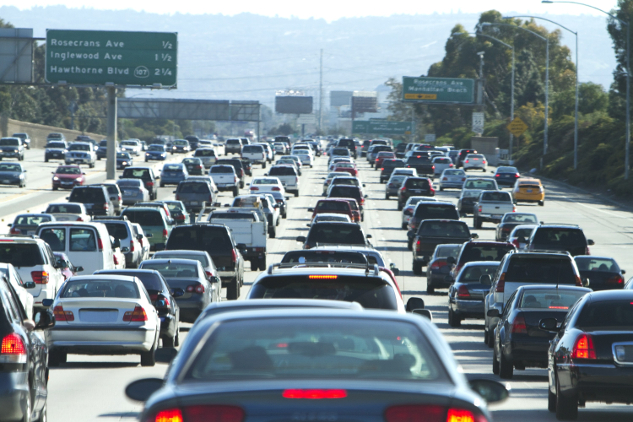
In This Article
- What is brake dust, and why should you care?
- How does brake dust compare to exhaust pollution in terms of health risks?
- What happens when you breathe in microscopic metal particles?
- How can we minimize our exposure to these hidden dangers?
Brake Dust vs. Exhaust Pollution: The Hidden Health Risks
by Robert Jennings,innerself.comFor decades, we’ve been led to believe that tailpipe emissions are the single worst thing about vehicle pollution. And to be fair, they’re no joke—carbon monoxide, nitrogen oxides, and volatile organic compounds have wreaked havoc on air quality and human health. But here’s the kicker: as car manufacturers have worked to clean up exhaust emissions, another problem has quietly taken center stage—brake dust.
Brake dust is the fine particulate matter released every time you press the brake pedal. Those pads and rotors wear down, sending tiny metal particles—including iron, copper, and manganese—into the air. Unlike exhaust fumes, which regulatory agencies have been forced to address, brake dust is largely unregulated and ignored. Yet, studies are now revealing that this seemingly invisible menace is just as dangerous—if not worse—than exhaust pollution.
How Brake Dust Impacts Your Health
So, what happens when you inhale brake dust? Nothing good. Researchers have found that these ultra-fine particles can penetrate deep into the lungs, where they trigger inflammation, oxidative stress, and even cardiovascular damage. Worse, some of these particles are so small that they pass into the bloodstream, where they contribute to the same health issues associated with diesel exhaust.
In one study, scientists exposed human lung cells to brake dust and found that it triggered the same toxic responses as diesel exhaust. That’s right—those tiny metal fragments shed from brake pads can wreak havoc on your lungs and heart just like the pollution we’ve been so desperate to reduce.
Here’s the irony: electric vehicles, hailed as the future of clean transportation, might not even fix this problem. EVs may have zero tailpipe emissions, but they still rely on braking systems that release dust into the air. And because EVs tend to be heavier due to their massive batteries, they may actually produce more brake dust than their gasoline counterparts. So much for a pollution-free future.
Brake Dust vs. Exhaust Pollution
Let’s break this down. When it comes to air pollution, both brake dust and exhaust emissions release harmful particulates. The difference? One has been heavily scrutinized, while the other has flown under the radar.
Exhaust emissions contain well-documented pollutants like carbon monoxide, nitrogen oxides, and soot—all known contributors to lung disease, heart disease, and climate change. Thanks to regulations like catalytic converters and emissions standards, modern vehicles have significantly reduced their exhaust pollution.
Brake dust, on the other hand, is essentially unregulated. It contains metal particles that trigger inflammation in the body, potentially leading to long-term respiratory and cardiovascular problems. Because these particles are ultra-fine, they can travel deep into the lungs and enter the bloodstream, leading to chronic health effects.
And let’s not forget: brake dust is a type of non-exhaust emission, meaning it’s completely unaffected by vehicle emissions standards. While automakers pat themselves on the back for reducing tailpipe pollution, the public is still breathing in toxic metallic particles every time they walk down a busy street.
Who’s Most at Risk?
Like most forms of pollution, brake dust disproportionately affects urban populations, particularly those living near high-traffic areas. Pedestrians, cyclists, and people who rely on public transportation are often the most exposed—especially in cities where braking is frequent due to stop-and-go traffic.
Children, the elderly, and those with preexisting respiratory conditions are at the highest risk. These groups already have compromised lung function, making them more vulnerable to the damaging effects of airborne particulates. So while wealthy suburbanites enjoy their filtered-air SUVs, inner-city residents are left breathing in a cocktail of toxic brake dust and exhaust fumes.
What Can Be Done?
Let’s be real—automakers and policymakers have little incentive to address this issue. Regulations on brake dust would require major changes to vehicle design, which the industry isn’t exactly eager to embrace. But that doesn’t mean nothing can be done.
First, there’s technology. Some manufacturers are experimenting with regenerative braking systems that reduce wear on brake pads, thereby lowering brake dust emissions. These systems, commonly found in hybrid and electric vehicles, rely on the electric motor to slow the car down, minimizing the need for traditional braking.
Second, cities can implement better air filtration measures, including more green spaces that naturally capture airborne particulates. Trees and vegetation along roadways can help trap these pollutants before they reach our lungs.
On a personal level, individuals can reduce their exposure by avoiding high-traffic areas when possible, using air purifiers in their homes, and ensuring their vehicles use high-quality, low-dust brake pads.
Time to Take Brake Dust Seriously
Brake dust may not be as visible as smog or as headline-grabbing as climate change, but its impact on human health is just as real. As exhaust emissions decrease, non-exhaust emissions like brake dust are becoming a larger slice of the pollution pie—and it’s time regulators and the public take notice.
In a world obsessed with electric vehicles and tailpipe emissions, we must remember that pollution isn’t just about what comes out of an exhaust pipe. Until brake dust is properly studied, regulated, and mitigated, we’re all left breathing in microscopic metal shrapnel with every step we take.
Now, who’s ready for a nice, deep breath of city air?
About the Author
 Robert Jennings is the co-publisher of InnerSelf.com, a platform dedicated to empowering individuals and fostering a more connected, equitable world. A veteran of the U.S. Marine Corps and the U.S. Army, Robert draws on his diverse life experiences, from working in real estate and construction to building InnerSelf with his wife, Marie T. Russell, to bring a practical, grounded perspective to life’s challenges. Founded in 1996, InnerSelf.com shares insights to help people make informed, meaningful choices for themselves and the planet. More than 30 years later, InnerSelf continues to inspire clarity and empowerment.
Robert Jennings is the co-publisher of InnerSelf.com, a platform dedicated to empowering individuals and fostering a more connected, equitable world. A veteran of the U.S. Marine Corps and the U.S. Army, Robert draws on his diverse life experiences, from working in real estate and construction to building InnerSelf with his wife, Marie T. Russell, to bring a practical, grounded perspective to life’s challenges. Founded in 1996, InnerSelf.com shares insights to help people make informed, meaningful choices for themselves and the planet. More than 30 years later, InnerSelf continues to inspire clarity and empowerment.
Creative Commons 4.0
This article is licensed under a Creative Commons Attribution-Share Alike 4.0 License. Attribute the author Robert Jennings, InnerSelf.com. Link back to the article This article originally appeared on InnerSelf.com
">About the Author
 Robert Jennings is the co-publisher of InnerSelf.com, a platform dedicated to empowering individuals and fostering a more connected, equitable world. A veteran of the U.S. Marine Corps and the U.S. Army, Robert draws on his diverse life experiences, from working in real estate and construction to building InnerSelf with his wife, Marie T. Russell, to bring a practical, grounded perspective to life’s challenges. Founded in 1996, InnerSelf.com shares insights to help people make informed, meaningful choices for themselves and the planet. More than 30 years later, InnerSelf continues to inspire clarity and empowerment.
Robert Jennings is the co-publisher of InnerSelf.com, a platform dedicated to empowering individuals and fostering a more connected, equitable world. A veteran of the U.S. Marine Corps and the U.S. Army, Robert draws on his diverse life experiences, from working in real estate and construction to building InnerSelf with his wife, Marie T. Russell, to bring a practical, grounded perspective to life’s challenges. Founded in 1996, InnerSelf.com shares insights to help people make informed, meaningful choices for themselves and the planet. More than 30 years later, InnerSelf continues to inspire clarity and empowerment.
Creative Commons 4.0
This article is licensed under a Creative Commons Attribution-Share Alike 4.0 License. Attribute the author Robert Jennings, InnerSelf.com. Link back to the article This article originally appeared on InnerSelf.com
books_health
Article Recap
Brake dust is a hidden health hazard that rivals exhaust pollution in its ability to harm human health. As vehicles reduce tailpipe emissions, non-exhaust emissions like brake dust are becoming a bigger concern. This article explored the composition of brake dust, its impact on respiratory and cardiovascular health, and how it compares to traditional exhaust pollution. With no regulations in place, brake dust remains a largely ignored but serious air quality threat.
#BrakeDust #HealthEffects #ExhaustPollution #AirQuality #VehicleEmissions



